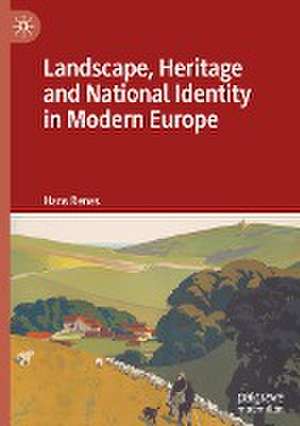Landscape, Heritage and National Identity in Modern Europe
Autor Hans Renesen Limba Engleză Hardback – 7 oct 2022
| Toate formatele și edițiile | Preț | Express |
|---|---|---|
| Paperback (1) | 343.98 lei 6-8 săpt. | |
| Springer International Publishing – 8 oct 2023 | 343.98 lei 6-8 săpt. | |
| Hardback (1) | 309.68 lei 3-5 săpt. | +16.37 lei 4-10 zile |
| Springer International Publishing – 7 oct 2022 | 309.68 lei 3-5 săpt. | +16.37 lei 4-10 zile |
Preț: 309.68 lei
Nou
Puncte Express: 465
Preț estimativ în valută:
59.26€ • 61.50$ • 49.53£
59.26€ • 61.50$ • 49.53£
Carte disponibilă
Livrare economică 25 februarie-11 martie
Livrare express 08-14 februarie pentru 26.36 lei
Preluare comenzi: 021 569.72.76
Specificații
ISBN-13: 9783031095351
ISBN-10: 3031095359
Pagini: 97
Ilustrații: XII, 97 p. 13 illus., 12 illus. in color.
Dimensiuni: 148 x 210 x 14 mm
Greutate: 0.29 kg
Ediția:1st ed. 2022
Editura: Springer International Publishing
Colecția Palgrave Macmillan
Locul publicării:Cham, Switzerland
ISBN-10: 3031095359
Pagini: 97
Ilustrații: XII, 97 p. 13 illus., 12 illus. in color.
Dimensiuni: 148 x 210 x 14 mm
Greutate: 0.29 kg
Ediția:1st ed. 2022
Editura: Springer International Publishing
Colecția Palgrave Macmillan
Locul publicării:Cham, Switzerland
Cuprins
1. Introduction.- 2 Terminology: landscape, heritage, identity and nationalism.- 3. Natural Landscapes.- 4. Timeless Agrarian Landscapes.- 5. Cultural Landscapes and Deep History.- 6. Landscapes of Glorious Times.- 7. Landscapes of Conflict and Trauma.- 8. New Landscapes.- 9. Concluding Remarks.
Notă biografică
Hans Renes retired in 2021 as a historical geographer at Utrecht University and professor of heritage studies at Vrije Universiteit Amsterdam, the Netherlands. He published on many different aspects of landscape history of the Netherlands and Europe as well as on the relation between landscape heritage and planning. He is co-editor of the Tijdschrift voor Historische Geografie and the recently launched Journal of European Landscapes.
Textul de pe ultima copertă
This book describes the way in which landscape and landscape heritage have been – and still are – used to define national identities. It shows how national narratives use different types of landscapes. Some nations use nature as their main point of reference, partly to circumcise conflicts between different ethnic groups. Other nations use agrarian landscapes, that are often describes as timeless and ‘rooted’. Again other nations use history as a major sources for defining identities. In these cases, myths of origins, ‘Golden Ages’ or wars and conflicts deliver the materials for national narratives. The final section describes how nation states developed new urban as well as rural landscapes as national showpieces. As landscapes are an important but under-researched aspect of nation-building, this book fills a gap in the study of nationalism.
Hans Renes retired in 2021 as a historical geographer at Utrecht University and professor of heritage studies at Vrije Universiteit Amsterdam, the Netherlands. He published on many different aspects of landscape history of the Netherlands and Europe as well as on the relation between landscape heritage and planning. He is co-editor of the Tijdschrift voor Historische Geografie and the recently launched Journal of European Landscapes.
Caracteristici
Considers the relationship between landscapes, heritage and national identity in modern Europe Explores how landscapes were mobilised in the development of national identities Illustrates the selective choice of various landscapes in identity formation
